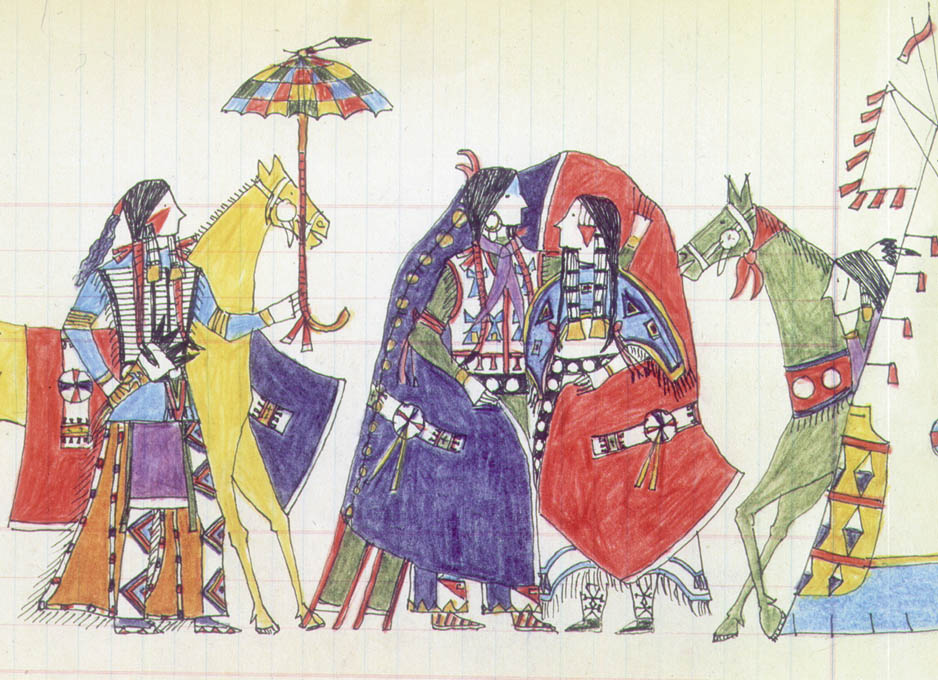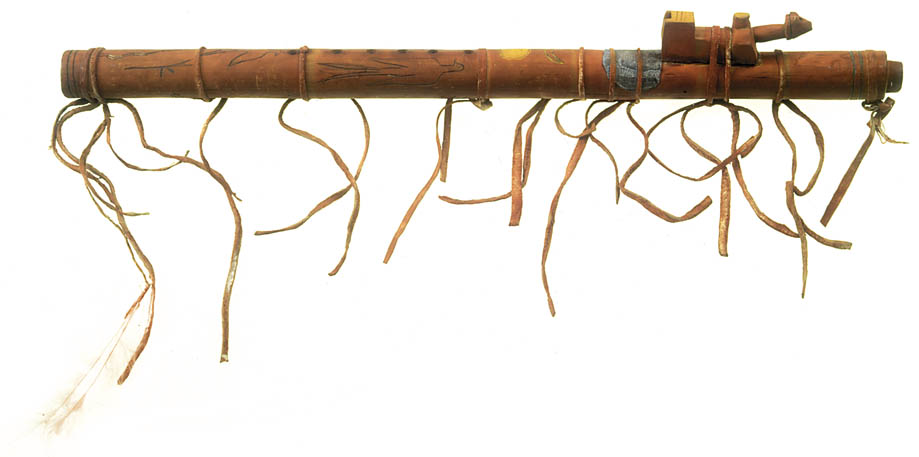

Courting on the Plains: 19th Century Lakota Style
by Kathryn M. Duda

In contemporary Native American societies, the
dating scene is a familiar one: dinner, movies, dancing. But things were
vastly different 100 years ago. A vignette entitled Lakota Courting Scene,
which is being prepared for the Museum of Natural History's Alcoa Foundation
Hall of American Indians (opening June 6-7), shows how young couples connected
on the Plains in the 19th century.
When a young man's thoughts turned to choosing a
bride, he needed several accessories-chief among them was a courting blanket,
often made for him by his sister. There was no mistaking the intentions
of a well-turned-out young man with a blanket draped over his arm and headed
for the tipi of an eligible young woman. Wrapping the blanket around himself
and his intended, the man provided a private place for the two to talk.
According to hall curator Marsha Bol, "he really created a piece of architecture,"
a shield to protect the couple from over-protective parents, curious onlookers
and the hot sun. The custom was called ina aopemni inajinpi, or "standing
wrapped in the blanket," and while its origin is uncertain, scholars do
know that it flourished until young people began going away to boarding
school beginning in the late 19th century.

|
This detail from a 1995 ledger by Thomas Red Owl Haukaas (b.1950) shows
a Lakota courting scene to be depicted in Aloca Hall of American Indians.
Contemporary Lakota artists like Haukaas have revived the century-old art
of ledger drawing that nostalgically recalls pre-reservation life.
The practice is so old that probably no one alive today
actually experienced it, but Lakota people are aware of it as a charming
part of their history. The details are kept alive through the oral tradition
and through ledger drawings, scenes of daily Plains life as depicted on
ledger paper obtained from U.S. Army soldiers, trading posts and settlers.
The scene depicted in Alcoa Hall is modeled after a contemporary ledger
drawing created by Lakota artist Thomas Red Owl Haukaas. It shows three
suitors-two waiting their turn while the first converses with the popular
girl. Besides the all-important blanket, the exhibit contains other 19th-century
materials needed for courting on the Plains. The men wear their finest
clothes and beaded moccasins. One even carries an umbrella, both fashionable
and practical on the treeless Plains a century ago. The men's hair is carefully
groomed, something their sisters often did for them on these special occasions,
and their skin is decorated with vermillion body paint. And if a fellow
needs some additional help, a courting flute is nearby for serenading.
On this instrument the Lakota man would play songs believed to be irresistible
to young women, and composed by a shaman according to instructions received
in a dream. In playing a love song on the courting flute, the suitor emulated
a bull elk that bugles to lure a mate in his direction. Young Lakota men
were aware of that animal's success in attacting females (one bull can
have a herd of some 60 cows), and they hoped to supernaturally harness
a bit of the elk's seductive powers. So they carried love charms made from
elk horn, wore clothing decorated with images of the animal, or decorated
their courting flutes with drawings of elk. In addition to the flutes,
the Alcoa Hall exhibit features a recording of a Lakota love song played
by Brian Akipa, a Lakota flutemaker/musician.
In the late 19th and early 20th centuries, young men played courting
flutes to attract women. The flutes were often decorated with images
of the bull elk, an animal revered for its success with females.

|
While Lakota people chuckle today about "standing wrapped
in the blanket," they are nevertheless reluctant to forget about it, realizing
that like so many of their ancestors' ways, it was an integral part of
life on the Plains.
Kathryn M. Duda is associate editor of Carnegie Magazine.
Contents
|
Highlights
|
Calendar
|
Back Issues
|
Museums
|
Copyright 1998 Carnegie Magazine
All rights reserved.


